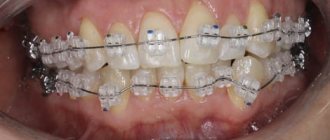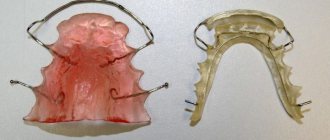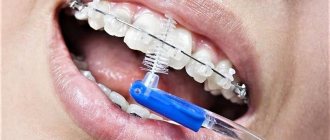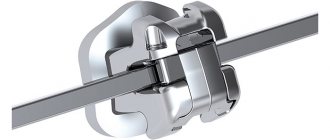In general, the period of wearing braces ranges from 1 to 3 years. But how to find out the exact timing? Orthodontic treatment involves more than just creating a beautiful smile. This also means restoring the functionality of the entire dentition. That's why the systems last so long. Bone and connective tissue are considered the densest. The pressure exerted on them to move must last for a long time. The optimal period is 1.5 years.
At a consultation appointment at the Propricus clinic, the orthodontist will first conduct an examination. This is necessary to assess the condition of the teeth and the entire dental system. Knowing the results, the orthodontist will be able to tell how long to wear braces.
How long does it take to install braces?
It is possible to answer exactly how long it will take to install braces for an adult or a teenager only after a preliminary consultation with a doctor. The fixation process itself usually takes 1-1.5 hours for any patient. Non-ligature structures are placed faster. Everything is purely individual and depends on each specific case.
However, it is first necessary to treat inflammatory processes in the mouth and have it professionally cleaned. Some designs are made individually, which also takes time: 1-2 weeks.
Resorption of tooth roots
First of all, it is necessary to talk about the resorption of tooth roots, if we say in general terms - about the resorption of roots. This process has not yet been fully studied and threatens the patient’s complete loss of teeth. Prolonged mechanical impact from the braces system often leads to resorption of the tooth bone tissue. It is very important, at the beginning, middle and at the end of the bite correction, to take diagnostic photographs and look at the condition of the roots, since resorption at the initial stage is completely asymptomatic. Treatment of root resorption is complex, multi-step and expensive. Quite often I hear from patients that a doctor installs a brace system without analyzing an OPTG or CBCT image, without impressions or any diagnostics. This is a gross, dangerous mistake, since the bracket system is not indicated in all cases, and setting it “at random” can lead to unpleasant and often irreversible consequences. Be careful when choosing a specialist.
How long do you wear traction on braces?
Rods (or rubber bands in other words) on brace systems are special rubber rings that are worn separately. Their purpose is to enhance the traction of the power arc to obtain faster and better correction results. The elastic bands are placed on the teeth approximately 4-5 months into orthodontic treatment. How long the braces are worn during the day depends on the clinical case: either 12 hours at night or around the clock.
Methods for attaching rubber bands:
- - on identical teeth of different jaws;
- - for 2 teeth in one jaw and 1 in the second;
- - square on 4 teeth (2 on top and 2 on bottom);
- - a combination of several options at once.
How long elastic bands are worn on braces is determined individually, but you need to plan for at least several months .
The principle of bite correction using a brace system
The classic system consists of directly braces (clasps), a power arch and ligatures. The clasps are fixed to the front surface of the teeth using an adhesive base. An arc is passed through them and secured with ligatures. In non-ligature designs, the arc clamps are already present on the clasps themselves.
The arch is the main element that ensures the movement of teeth. It is first given the “correct” shape, to which, thanks to the properties of the material, it tends to return. This ensures constant pressure on the teeth. As the periodontal ligaments and bone tissue gradually adapt to this traction, they become in the desired position.
FAQ
Why can’t I wear regular compression stockings during surgery?
Anti-embolic hosiery is designed specifically for hospital stays, so “regular” compression hosiery is not suitable for this purpose.
Hospital knitwear is white - this is necessary to monitor the condition of the veins during surgery. Regular compression knitwear does not have this color range. Hospital stockings have a special hole in the toe area, which is also necessary to monitor the patient’s condition.
Hospital knitwear has a certain knitting of threads, which allows you to stay in the products for a long time.
Is it true that hospital jersey is difficult to put on?
Yes it is. Also, not everyone can put on knitwear lying down. If you find it difficult to put on knitwear on your own, you can ask your relatives or medical staff for help.
What is the cost of anti-embolic jersey?
The better the quality of the knitwear, the higher its cost. The quality of knitwear is measured in the long-term preservation of compression properties. Also, a number of advantages can affect the cost: special knitting for a comfortable stay in the product, antibacterial properties, good fixation on the leg, and the like.
What factors affect wearing time?
- 1. Age. Bone tissue and ligaments in adolescents are more plastic, so eliminating bite problems of any complexity before the age of 18 requires an average of 3-6 months less time. This does not mean that complex defects cannot be corrected for an adult, but more time will have to be spent.
- 2. Complexity of the defect. The severity of the anomaly and its type also affect the timing of treatment. Even the most advanced cases of crowding are corrected faster than problems with jaw closure.
- 3. Type of system. The material and design of braces affect the timing. Non-ligature metal structures are the fastest to correct. Lingual ones take the longest, but they are invisible.
- 4. Doctor's experience. Optimal selection of the system, correct installation, control of tooth displacement - parameters that depend on the experience of the orthodontist. In our clinic, doctors are constantly improving their skills, so they can correct your bite in a minimum amount of time.
- 5. Patient compliance with recommendations. Following a diet and proper care of systems are also important. Damage to structures and the development of caries can cause a suspension of correction or a decrease in the effectiveness of treatment.
How to choose a jersey size
To choose compression stockings for surgery, you first need to measure your legs. To select the correct knitwear, this procedure is done immediately after waking up - before the legs have time to swell.
Necessary parameters when measuring:
- The circumference of the ankle at its narrowest part.
- Calf circumference at its widest part.
- The circumference of the thigh is in the area five centimeters below the gluteal fold.
After this, based on the parameters obtained during measurements, you select the size of the jersey according to the size table. You will see such a table in any product card on the Ortix website. If you have any difficulties with the selection, you can consult our specialists by phone.
Type of braces and duration of treatment
Depending on the type of system, the duration of treatment varies:
- 1. Metal: the fastest and most effective.
- 2. Ceramic: due to fragility, they last a little longer than metal.
- 3. Sapphire: quite fragile, which increases the wearing period.
- 4. Lingual: the longest wearing period is 2-2.5 years, but the best aesthetics.
- 5. Self-ligating: on average 1-1.5 years.
- 6. Ligature: longer than non-ligature, but the exact period depends on the material.
Buy hospital knitwear →
See all
- 20% discount
- Leader
Anti-embolic stockings Thrombexin 18 914
In stock
2,300 rub. from 1,840 rub.
Buy
Code: 007853
medi, Germany
- Leader
Anti-embolic stockings Luomma Idealista 1 class ID-380
In stock
1,600 rub.
Buy
Code: 007848
LUOMMA IDEALISTA, Russia
- Leader
Anti-embolic stockings Luomma Idealista class 2 ID-380
In stock
RUR 2,400
Buy
Code: 010517
LUOMMA IDEALISTA, Russia
In stock
RUB 1,550
Buy
Code: 012636
LUOMMA IDEALISTA, Russia
In stock
RUB 3,950
Buy
Code: 007851
medi, Germany
In stock
from RUR 2,805
Buy
Code: 007854
TONUS ELAST, Latvia
- 20% discount
Anti-embolic stockings Ergoforma (Ergoforma) class 2 227
In stock
RUB 1,925 from 1,540 rub.
Buy
Code: 007847
ERGOFORMA, Italy
- 20% discount
Anti-embolic stockings Ergoforma (Ergoforma) class 1 217
In stock
RUB 1,710 from RUR 1,368
Buy
Code: 007846
ERGOFORMA, Italy
- 20% discount
Anti-embolic PCI stocking up to the thigh, class 2, circular knit
In stock
550 rub. from 440 rub.
Buy
Code: 007862
LPP FARM, Russia
In stock
390 rub.
Buy
Code: 007863
LPP FARM, Russia
- 20% discount
Anti-embolic stockings Struva 23 917
In stock
RUB 3,500 from 2,800 rub.
Buy
Code: 007849
medi, Germany
In stock
RUB 2,350
Buy
Code: 007861
medi, Germany
Minimum and maximum wearing time
The average period of wearing braces is 1-1.5 years. You need to be prepared for this even before visiting the orthodontist. During the initial consultation, the doctor determines the specific duration of the correction, but the timing may change during the course of treatment.
The minimum period for wearing braces is 6 months. This usually applies to children with minor defects. But it is not possible to determine how long braces can be worn. Usually doctors talk about 2.5-3 years. The known record of correction by the system: 9 years and 8 months.
How long should children wear braces?
The child’s dentofacial apparatus is easier to correct even in difficult clinical situations. Therefore, the duration of correction is significantly less than for an adult. 12-16 years old needs to wear braces can only be found out at an appointment with an orthodontist, but rarely longer than 2 years .
How long should adults wear braces?
The dental system of an adult is much less susceptible to external influences. There are several reasons for this:
- 1. The dentofacial apparatus is fully formed.
- 2. Bone tissue is denser.
- 3. Restorative processes in tissues are slowed down.
- 4. The speed of any exchange processes is reduced.
18-30 should wear braces . Even minor defects may require treatment for 1.5-2 years. Advanced cases can take 3 or more years to resolve.
When can you remove braces?
The process of occlusion correction consists of several stages; the structures can be removed after completion of the last one. First, the teeth are aligned along the arch, then the main formation of the bite occurs (the teeth are moved forward or backward, gaps are removed, the position of the jaws is corrected), and finally minor defects are eliminated. An orthodontist removes braces in a dental office.
In some cases, braces have to be removed ahead of schedule:
- - development of inflammatory processes in the oral cavity;
- - allergic reaction to elements of the system (most often to metal);
- - poor oral hygiene;
- - the need for surgery to correct the bite.
If possible, after removing the treatment limitation, the system is reinstalled. Otherwise, an alternative method of orthodontic treatment is selected.
How long do you wear retainers after braces?
Fixed retainer
Orthodontic treatment does not end after the braces are removed. Consolidating the correction result requires wearing special mouthguards (retainers). They fix the teeth in the correct position and prevent them from returning to their original incorrect position under the influence of chewing loads.
Retainers are removable and non-removable . The first ones are removed during meals, are noticeable and require self-discipline. The second ones are fixed and removed by a doctor and are not visible to others. As a rule, the patient is first prescribed permanent wearing of non-removable plates. Then he switches to using removable ones around the clock, gradually starting to wear them only at night.
Removable retainer
The orthodontist decides how long to wear the retainer after braces are removed. On average, the time it takes to consolidate the results with mouth guards is 2-3 times longer than the duration of the treatment itself: 3-6 years . For adults with corrected advanced malocclusions, retainers may be recommended for life.
Posted by:
Interdisciplinary reception
It often happens that malocclusions are much more complex and treatment with braces alone is not enough.
Often, treatment, for one reason or another, is delayed or does not go according to plan, or is initially planned incorrectly, which creates a lot of problems physically and psychologically for both the patient and the doctor. Therefore, I strongly recommend that you undergo a detailed diagnosis before orthodontic treatment. Calculation of casts, images, CBCT analysis, determination of central occlusion and central relationship of the jaws. According to the indications, axiography. This will allow you to make an accurate diagnosis. Accurate diagnosis = correct treatment plan. The orthodontist must have the skill, knowledge and ability to conduct interdisciplinary treatment. Your treatment will be monitored simultaneously by the orthodontist and related professionals: orthopedist, surgeon, gnathologist, periodontist, therapist, endodontist, and, if necessary, an osteopath. If necessary, during orthodontic treatment, a competent orthodontist with interdisciplinary experience will attract the necessary specialists to provide timely assistance. This work in conjunction allows you to speed up treatment and avoid complications. Treat previously undetected caries in a timely manner, rather than wait for further tooth destruction under braces until removal. Or, for example, if there are periodontal problems, then your doctor will treat in accordance with the treatment protocols of the periodontist, constantly communicating with each other.
Patients with TMJ disease must first undergo a full diagnostic with axiography, and, if necessary, therapeutic and diagnostic splint therapy from a gnathologist. This therapy allows you to put the joint in the correct position. This correct position may not seem entirely comfortable to the patient; the teeth may touch at completely different points than before. But it is only from this functional position (in case of TMJ pathology) that it is possible to begin orthodontic treatment, so that incorrect movements do not cause more harm to an already suffering person.











